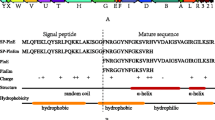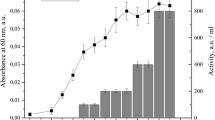Abstract
Lactobacillus plantarum produces bacteriocin called plantaricin that can kill or inhibit other bacteria. Plantaricin E (Pln E), a recombinant bacteriocin, has been successfully constructed and produced by a GRAS host, Lactococcus lactis. A polymerase chain reaction (PCR) overlapping technique has been used to construct a ligation of signal peptide gene, Pln A and bacteriocin encoding gene, Pln E. Furthermore, the fusion fragment were cloned into pNZ8148 vector and transformed into L. lactis NZ3900. Molecular expression study shows that recombinant L. lactis NZ3900 is able to express the mature pln E at transcription level with size of 168 bp. Plantaricin E is purified by ammonium sulphate precipitation followed by gel filtration chromatography. Purified fractions were proven to be active against Enteropathogenic Escherichia coli K.1.1. The other fractions of Pln E also have antibacterial activity against several Gram positive and Gram negative bacteria. Purified recombinant plantaricin E is 3.7 kDa in size. The cytotoxicity assay shows purified Pln E inhibits 46.949 ± 3.338% of HeLa cell lines on 10 ppm dose whilst the metabolite inhibits 53.487 ± 2.957% of HeLa cell line on 100 ppm dose. The IC50 calculation of Pln E metabolite is 107.453 ppm, while the purified protein is 11.613 ppm.





Similar content being viewed by others
References
Kementerian Kesehatan Indonesia (2011) Buletin Diare. [Online] Available from: http://www.depkes.go.id/folder/view/01/structure-publikasi-pusdatin-buletin.htmL. Accessed 10 June 2017
Croxen MA, Law RJ, Scholz R, Keeney KM, Wlodarska M, Finlay BB (2013) Recent advances in understanding enteric pathogenic Escherichia coli. Clin Microbiol Rev 26:822–880
Bhunia AK (2011) Foodborne microbial pathogen: mechanism and pathogenesis. Springer, New York
Kaper JB, Nataro JP, Mobley HLT (2004) Pathogenic Escherichia coli. Nature Rev Microbiol 2:123–140
Madigan MT, Martinko JM, Bender KS, Buckley DH, Stahl DA (2015) Brock biology of microorganism, 14th edn. Pearson, Boston
Budiarti S (1997) Perlekatan pada sel HEP-2 dan keragaman serotipe O Escherichia coli enteropatogenik isolat Indonesia. B I Ked 29:105–109
Budiarti S, Mubarik NR (2007) Extracellular protease activity of enteropathogenic Escherichia coli on mucin substrate. Hayati J Biosci 14:36–38
Budiarti S (2011) Antibiotic resistance Escherichia coli isolated from faecal of healthy human. J Int Environ Appl Sci 6:359–364
Borrero J, Jiménez JJ, Gútiez L, Herranz C, Cintas LM, Hernández PE (2011) Protein expression vector and secretion signal peptide optimization to drive the production, secretion, and functional expression of the bacteriocin enterocin A in lactic acid bacteria. J Biotechnol 156:76–86
Tsapieva A, Duplik N, Suvorov A (2011) Structure of plantaricin locus of Lactobacillus plantarum 8P-A3. Benef Microbes 2:255–261
Todorov S, Nyati H, Meincken M, Dicks LMT (2007) Partial characterization of bacteriocin AMA-K, produced by Lactobacillus plantarum AMA-K isolated from naturally fermented milk from Zimbabwe. Food Control 18:656–664
Hata T, Tanaka R, Ohmomo S (2010) Isolation and characterization of plantaricin ASM1: a new bacteriocin produced by Lactobacillus plantarum A-1. Int J Food Microbiol 137:94–99
Sihombing DE, Arief II, Budiarti S (2015) Application of antimicrobial agents produced by Lactobacillus plantarum IIA-IA5 as natural preservative on beef during room temperature storage. Adv J Food Sci Technol 8:251–255
Villarante KI, Elegado FB, Iwatani S, Zendo T, Sonomoto K, de Guzman EE (2011) Purification, characterization and in vitro cytotoxicity of the bacteriocin from Pediococcus acidilacti K2a2-3 against human colon adenocarcinoma (HT29) and human cervical carcinoma (HeLa) cell. World J Microbiol Biotechnol 27:975–980
Avaiyarasi ND, Rafindran AD, Venkatesh P, Arul V (2016) In vitro selection, characterization, and cytotoxic effect of bacteriocin of Lactobacillus sakei GM3 isolated from goat milk. Food Control 69:124–133
Zhao H, Sood R, Jutila A, Bose S, FimLand G, Nissen-Meyer J et al (2006) Interaction of the antimicrobial peptide pheromone plantaricin A with model membranes: implications for a novel mechanism of action. Biochim Biophys Acta 1758:1461–1474
Paiva AD, de Oliveira MD, dePaula SO, Baracat-Pereira MC, Breukink E, Mantovani HC (2012) Toxicity of bovicin HC5 against mammalian cell lines and the role of cholesterol in bacteriocin activity. Microbiology 158:2851–2858
Mustopa AZ, Umami RN, Budiarto RB, Danuri H (2016) Cloning and expression of plantaricin E and F genes of Lactobacillus plantarum S34 isolated from Indonesia traditional-fermented meat (bekasam). Int Food Res J 23:762–769
Budiarto BR, Mustopa AZ, Indarmawan T (2015) Characterization of partial extracellular protease from bekasam-isolated L. plantarum S31 and its application to hydrolize skimmed-milk with antibacerial property. Int Food Res J 23:340–349
Mustopa AZ (2013) Isolation and characterization of Lactobacillus plantarum S34 from Indonesian traditional food. PhD thesis, Dankook University, Seoul, KR
Kusdianawati K, Mustopa AZ, Suharsono S, Budiarto BR, Fatimah, Danuri H (2015) Construction, expression and purification of recombinant pre-mature peptide of plantaricin F from Lactobacillus plantarum S34 in Escherichia coli. Indones J Agric Sci 16:31–38
Martinez FAC, Balciunas EM, Salgado JM, Dominguez-Gonzales JM, Converti A, Oliveira RPS (2013) Lactic acid properties, applications and production: a review. Trends Food Sci Technol 30:70–83
Cotter PD, Hill C, Ross RP (2005) Bacteriocins: developing innate immunity for good. Nat Rev Microbiol 3:777–788
Smith L, Hilman JD (2008) Therapeutic potential of type a (I) lantibiotics, a grup of cationic peptide antibiotics. Curr Opin Biotechnol 11:401–408
Pal G, Srivastava S (2014) Cloning and heterologous expression of plnE, -F, -J and -K genes derived from soil metagenome and purification of active plantaricin peptides. Appl Microbiol Biotechnol 98:1441–1447
Mustopa AZ, Murtiyaningsih H, Fatimah S (2016) Cloning and heterologous expression of extracellular plantaricin F produced by Lactobacillus plantarum S34 isolated from “Bekasam” in Lactococcus lactis. Microbiol Indones 10:95–106
Lages AC, Mustopa AZ, Sukmarini L, Suharsono (2015) Cloning and expression of plantaricin W produced by Lactobacillus plantarum U10 isolate from ‘Tempoyak’ Indonesian fermented food as immunity protein in Lactococcus lactis. Appl Biochem Biotechnol 177:909–922
Purramattahu TV, Islam MR, Nishie M, Yanagihara S, Nagao J, Okuda K et al (2012) Enhanced production of nukacin D13E in Lactococcus lactis NZ9000 by the additional expression of immunity genes. Appl Microbiol Biotechnol 93:671–678
Mierau I, Olieman K, Mond J, Smid EJ (2005) Optimization of the Lactococcus lactis nisin-controlled gene expression system NICE for industrial applications. Microb Cell Fact 4:16
Zhu H, Qu F, Zhu LH (1993) Isolation of genomics DNAs from plants, fungi, and bacteria using benzyl chloride. Nucl Acids Res 21:5279–5280
Duan K, Dunn NW, Kim WS (1999) Rapid plasmid DNA isolation from Lactococcus lactis using overnight cultures. Biotechnol Tech 13:19–521
Sambrook J, Fritsch EF, Maniatis T (1993) Molecular cloning: a laboratory manual. Cold Spring Harbor Laboratory Press, Cold Spring Harbor
Sambrook J, Russel D (2002) Molecular cloning: A laboratory manual, 3rd ed. Cold Spring Harbor Laboratory Press, Cold Spring Harbor
Xie Y, An H, Hao Y, Qin Q, Huang Y, Luo Y et al (2011) Characterization of an anti-Listeria bacteriocin produced by Lactobacillus plantarum LB-B1 isolated from koumiss, a traditionally fermented dairy product from China. Food Control 22:1027–1031
Bauer AW, Kirby WMM, Sherris JC, Turck M (1966) Antibiotic susceptibility testing by a standaridizes single disc method. Am J Clin Pathol 45:493–496
Barbosa MS, Todorov SD, Ivanova IV, Belguesmia Y, Choiset Y, Rabesona H et al (2016) Characterization of a two-peptide plantaricin produced by Lactobacillus plantarum MBSa4 isolated from Brazilian salami. Food Control 60:103–112
Schagger H (2006) Tricine-SDS-PAGE. Nat Protoc 1:16–22
Abbasiliasi S, Tan JS, Ibrahim TA, Kadkhodaei S, Ng HS, Vakhshiteh F et al (2014) Primary recovery of a bacteriocin-like inhibitory substance derived from Pediococcus acidilacti Kp10 by an aqueous two-phase system. Food Chem 151:93–100
Nursid M, Wikanta T, Fajarningsih ND, Marraskuranto E (2006) Aktivitas sitotoksik, induksi apoptosisdan ekspresi gen p53 fraksi methanol spons Petrosia cf. nigricans terhadap sel tumor HeLa. JPBKP 1:103–109
Sand SL, Oppegård C, Ohara S, Iijima T, Naderi S, Blomhoff HK et al (2010) Plantaricin A, a peptide pheromone produced by Lactobacillus plantarum, permeabilizes the cell membrane of both normal and cancerous lymphocytes and neuronal cells. Peptides 31:1237–1244
Wu C, Zhang J, Du G, Chen J (2013) Heterologous expression of Lactobacillus casei RecO improved the multiple-stress tolerance and lactic acid production in Lactococcus lactis NZ9000 during salt stress. Bioresour Technol 143:238–241
Le Loir Y, Azevedo V, Oliveira SC, Freitas DA, Miyoshi A, Bermudez-Humaran LG et al (2005) Protein secretion Lactococcus lactis: an efficient way to increase the overall heterologous protein production. Microb Cell Fact 4:2
Mierau I, Kleerebezem M (2005) 10 years of the nisin-controlled gene expression system (NICE) in Lactococcus lactis. Appl Microbiol Biotechnol 68:705–717
Borrero J, Jimenez JJ, Gutiez L, Herranz C, Cintas LM, Hernandez PE (2011) Use of the usp45 lactococcal secretion signal sequence to drive the secretion and functional expression of enterococcal bacteriocins in Lactococcus lactis. Appl Microbiol Biotechnol 89:131–143
Todorov SD, van Reenen CA, Dicks LMT (2004) Optimization of bacteriocin production by Lactobacillus plantarum ST13BR, a strain isolated from barley beer. J Gen Appl Microbiol 50:149–157
Wen LS, Philip K, Ajam N (2016) Purification, characterization and mode of action of plantaricin K25 produced by Lactobacillus plantarum. Food Control 60:430–439
Rumjuankiat K, Perez RH, Pilasombut K, Keawsompong S, Zendo T, Sonomoto K et al (2015) Purification and characterization of a novel plantaricin, KL-1Y, from Lactobacillus plantarum KL-1. World J Microbiol Biotechnol 31:983–994
Pal G, Srivastava S (2014) Inhibitory effect of plantaricin peptides (Pln E/F and J/K) against Escherichia coli. World J Microbiol Biotechnol 30:2829–2837
Van Meerloo J, Kaspers GL, Cloos J (2011) Cell sensitivity assay: the MTT assay. In: Cree IA, 2nd edn. Springer Science + Business Media (LLC), Portsmouth
Acknowledgements
This research was funded by Insentif Riset Sistem Inovasi Nasional (INSINAS) program from Ministry of Research, Technology, and Higher Education fiscal year 2016–2017 and KKP3N Program from Indonesian Agency for Agricultural Research and Development (IAARD), Ministry of Agriculture fiscal year 2014–2015. All facilities were supported by Biotechnology-Indonesian Institute of Science (LIPI) and Indonesian Center for Agricultural Biotechnology and Genetic Resources Research and Development (ICABIOGRAD), Ministry of Agriculture. The authors would like to thank to Muhminah for her assistance.
Author information
Authors and Affiliations
Corresponding author
Ethics declarations
Conflict of interest
The authors declare that they have no conflict of interest.
Ethical approval
This article does not contain any studies with human or animal subjects performed by any of the authors.
Rights and permissions
About this article
Cite this article
Mustopa, A.Z., Mariyah, S., Fatimah et al. Construction, heterologous expression, partial purification, and in vitro cytotoxicity of the recombinant plantaricin E produced by Lactococcus lactis against Enteropathogenic Escherichia coli K.1.1 and human cervical carcinoma (HeLa) cells. Mol Biol Rep 45, 1235–1244 (2018). https://doi.org/10.1007/s11033-018-4277-6
Received:
Accepted:
Published:
Issue Date:
DOI: https://doi.org/10.1007/s11033-018-4277-6




